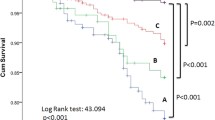Abstract
Series of studies have described malnutrition as one of the main non-traditional risk factors associated with poor prognosis and treatment outcome in patients on hemodialysis (HD). The aims of this study were to evaluate the link between HD treatment quality and the nutritional status and to additionally investigate the association of malnutrition and overall survival. A total of 134 adult out-patients (56.4% male, mean age 60.8 ± 16.15 years) were enrolled in the study. Clinical and laboratory data were obtained from the medical records. Anthropometric measurements were performed prior to HD. Malnutrition–Inflammation Score (MIS) was used as a scoring system representing the severity of protein-energy wasting (PEW). Malnourished patients were significantly older when compared to non-malnourished patients. They had significantly longer dialysis vintage and lower residual diuresis, BMI, serum proteins, and albumins and lean tissue index (LTI). Malnourished patients survived significantly shorter than non-malnourished patients. Hypoproteinemic patients had significantly lower values of serum albumins and LTI and survived shorter than normoproteinemic patients. Only malnourishment and age were associated with higher overall mortality in all groups of patients. By focusing on MIS and serum protein status rather than dialysis-related factors and different treatment techniques, we could accomplish better nutrition status and improved overall outcomes. While anticipating new and more effective measures for preventing malnutrition, our results clearly demonstrate that striving for the highest possible nutrition status should be one of the key strategies in improving the outcomes in this specific group of patients.



Similar content being viewed by others
References
Stenvinkel P. Malnutrition and chronic inflammation as risk factors for cardiovascular disease in chronic renal failure. Blood Purif. 2001;19:143–51.
Kalantar-Zadeh K, Kopple JD. Relative contributions of nutrition and inflammation to clinical outcome in dialysis patients. Am J Kidney Dis. 2001;38:1343–50.
Kalantar-Zadeh K, Kopple JD, Block G, Humphreys MH. A malnutrition-inflammation score is correlated with morbidity and mortality in maintenance hemodialysis patients. Am J Kidney Dis. 2001;38:1251–63.
Fouque D, Kalantar-Zadeh K, Kopple J, et al. A proposed nomenclature and diagnostic criteria for protein-energy wasting in acute and chronic kidney disease. Kidney Int. 2008;73:391–8.
Kopple JD, Zhu X, Lew NL, Lowrie EG. Body weight-for-hight relationships predict mortality in maintenance hemodialysis patients. Kidney Int. 1999;56:1136–48.
Stenvinkel P, Barany P, Heimburger O, Pecoits-Filho R, Lindholm B. Mortality, malnutrition, and atherosclerosis in ESRD: what is the role of interleukin-6? Kidney Int. 2002;61:103–8.
Kopple JD. Effect of nutrition on morbidity and mortality in maintenance hemodialysis patients. Am J Kidney Dis. 1994;24:1002–9.
Kalantar-Zadeh K, Block G, McAllister CJ, Humphreys MH, Kopple JD. Appetite and inflammaiton, nutrition, anemia, and clinical outcome in hemodialysis patients. Am J Clin Nutr. 2004;80:299–307.
Stenvinkel P. Inflammatory and atherosclerotic interactions in the depleted uremic patient. Blood Purif. 2001;19:53–61.
Kaizu Y, Kimura M, Yoneyama T, Miyaji K, Hibi I, Kumagai H. Interleukin-6 may mediate malnutrition in chronic hemodialysis patients. Am J Kidney Dis. 1998;31:93–100.
Kraut JA, Madias NE. Consequences and therapy of the metabolic acidosis of chronic kidney disease. Pediatr Nephrol. 2011;26:19–28.
Bonanni A, Mannuci I, Verzola D, et al. Protein-Energy wasting and mortality in chronic kidney disease. Int J Environ Res Public Health. 2011;8:1631–54.
Locatelli F, Mastrangelo F, Redaelli B, et al. Effects of different membranes and dialysis technologies on patient treatment tolerance and nutrition parameters. The Italian Cooperative Dialysis Study Group. Kidney Int. 1996;50:1293–302.
Parker TF 3rd, Wingard RL, Husni L, Ikizler TA, Parker RA, Hakim RM. Effect of the membrane biocompatibility on nutritional parameters in chronic hemodialysis patients. Kidney Int. 1996;49:551–6.
Marcus RG, Cohl E, Uribarri J. Protein intake seems to respond to increases in Kt/V despite baseline Kt/V greater than 1.2. Am J Nephrol. 1999;19:500–4.
Levin A. The advantage of a uniform terminology and staging system for chronic kidney disease (CKD). Nephrol Dial Transplant. 2003;18:1446–51.
Foley RN, Parfrey PS, Sarnak MJ. Clinical epidemiology of cardiovascular disease in chronic renal failure. Am J Kidney Dis. 1998;32:112–9.
Cianciaruso B, Brunori G, Kopple JD, et al. Cross-sectional comparison of malnutrition in continuous ambulatory peritoneal dialysis and hemodialysis patients. Am J Kidney Dis. 1995;26:475–86.
Dwyer JT, Cunniff PJ, Maroni BJ, The hemodialysis pilot study: nutrition program and participant characteristics at baseline. The HEMO Study Group. J Ren Nutr. 1998;8:11–20
Kluthe R, Lüttgen FM, Capetianu T, Heinze V, Katz N, Südhoff A. et al. Protein requirements in maintenance hemodialysis. Am J Clin Nutr 1978;3110:1812–1820.
Kopple JD, Berg R, Houser H, Steinman TI, Teschan P. Nutritional status of patients with different levels of chronic renal insufficiency. Modification of Diet in Renal Disease (MDRD) Study Group. Kidney Int. 1989;36:184–94.
Schoenfeld PY, Henry RR, Laird NM, Roxe DM. Assessment of nutritional status of the National Cooperative Dialysis Study population. Kidney Int. 1983;23:80–8.
Leon JB, Majerle AD, Soinski JA, Kushner I, Ohri-Vachaspati P, Sehgal AR. Can a nutrition intervention improve albumin levels among hemodialysis patients? A pilot study. J Ren Nutr. 2001;11:9–15.
Akpele L, Bailey JL. Nutrition counseling impacts serum albumin levels. J Ren Nutr. 2004;14:143–8.
Johansen Kl. Exercise and chronic kidney disease: Current recommendations. Sports Med. 2005;35:485–99.
Fouque D, McKenzie J, de Mutsert R, et al. Use of a renal-specific oral supplement by haemodialysis patients with low protein intake does not increase the need for phosphate binders and may prevent a decline in nutritional status and quality of life. Nephrol Dial Transplant. 2008;23:2902–10.
Author information
Authors and Affiliations
Corresponding author
Ethics declarations
Conflict of interest
The authors declare that they have no conflict of interest.
Additional information
Publisher’s Note
Springer Nature remains neutral with regard to jurisdictional claims in published maps and institutional affiliations.
Rights and permissions
About this article
Cite this article
Katalinic, L., Premuzic, V., Basic-Jukic, N. et al. Hypoproteinemia as a factor in assessing malnutrition and predicting survival on hemodialysis. J Artif Organs 22, 230–236 (2019). https://doi.org/10.1007/s10047-019-01098-3
Received:
Accepted:
Published:
Issue Date:
DOI: https://doi.org/10.1007/s10047-019-01098-3




